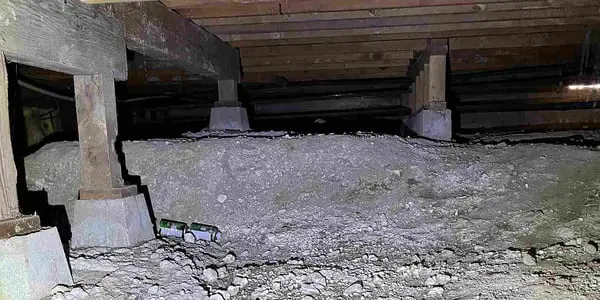Do you have sloping, slanted, or bowed floors and you’re not certain why? Are your floors no longer even with the trim?
Unlevel floors not only prove a major annoyance but a dangerous trip hazard. Before repairs can begin, it’s imperative to get to the bottom of the source. If you want to learn what exactly causes your home’s floor to become unlevel, this article is for you.
Dalinghaus Construction Inc. has assisted hundreds of homeowners in Southern California and Arizona reclaim their unlevel, sloping floors since 2015. We have over a hundred years of combined foundation repair experience and believe well-educated homeowners make the best decisions.
This article covers sloped floors caused by subfloor problems, framing issues, and foundation settlement. By the end of this article, you will understand how expansive soil can play a major role in sloping floors.

Sloping Floors Caused by Subfloor Problems
Your home’s subfloor is the bottom layer of flooring which provides a level, stable surface for the underlayment and the surface flooring (carpet, hardwood, linoleum). For raised foundations, subfloors are generally comprised of plywood and sit directly atop the foundation’s joists.
Due to environmental factors, wooden subfloors are particularly susceptible to water damage: rot, mold, and disintegration. Soggy subfloors provide a spongy walking experience, bow your floors and, occasionally, collapse.
However, more often than not, it is not the subfloor itself but the support system beneath it that results in sloped floors. The stem walls, posts and pads, or cripple walls underneath your home may begin to settle unevenly, causing the floor to dip in the areas where there’s a lack of support.
If you have a post and pad foundation, the easiest form of floor releveling is simply post and pad replacement.
Post and pad replacement is a quick turn-around repair, typically only taking a day, and costs between $5-$30k depending on the size of the home. To learn more about post and pad replacement, read our article Post and Pad Foundation Repair (Definition, Repair Process, & Cost).
Sloping Floors Caused by Busted Floor Joists
A more difficult repair than post and pad replacement when it comes to crawlspace foundations is joist repair. Wooden floor joists are extremely susceptible to moisture damage (rot, mold, and disintegration). This can result from poor drainage, a water leak, and past flooding.
In addition, if floor joists are improperly implemented to begin with, the wood can warp out of place. This is commonly seen in older homes with inadequate architectural design.
An easy way to check your joists is to shimmy into your crawlspace with a level. If your wooden foundation joists appear to have wood rot, are soft/spongy, and are warped – this is indicative the compromised joists are the primary reason for your sloped floor.
In addition to joists, rotten wooden sills (a section of wood that sits between the stemwall foundation walls and supports the floor joists, are prone to water damage. These are difficult to replace because they involve temporarily elevating your home to remove the rotten sill.
Once the rotten sills and joists have been replaced, your home’s sloped floor should return to level.
Sloping Floors Caused by Window/Door Framing Issues
In older homes, window and doorframes weaken over time and result in the floor above them to sink – the old frame unable to competently support the home’s load. This is usually seen in basement windows (as the framing helps support a substantial amount of the home’s weight).
Sloping Floors Caused by Foundation Settlement Issues
As a general rule of thumb, your floor is only as level as what it’s sitting on top of – aka, the ground/grade. Over time, foundations sink into incompetent, non-load-bearing soil, causing the interior floor to slope or slant.
This weak soil is referred to as expansive soil because it e x p a n d s when there is excess moisture and shrinks when the moisture dries out. This cyclical expansion and shrinkage exerts undue stress on your foundation and, in effect, can bury portions of your foundation.
Types of expansive soil include:
- Clays
- Loams
- Silts
It doesn’t matter what type of foundation you have: slab on grade, post-tensioned, stemwall, cripple wall, or post and pad – foundation settlement caused by expansive soil can slope your floors. Foundation settlement is the most common reason for sloped floors.
Common forms of re-leveling foundations, in order to relevel sloping floors, include:
- Underpinning
- Slab/mudjacking
- Polyurethane injection
Here at Dalinghaus Construction Inc., we believe the best way to deal with expansive soil and foundation settlement is through steel pier underpinning. Steel pier underpinning with push piers or helical piers allows for the foundation to be lifted and re-leveled – leveling out your uneven sloped floors once and for all.
Check out our case study: Repairing Uneven Floors At Settling Spring Valley Home
Is Steel Pier Underpinning Right for You?
In this article, you learned about 3 common causes of sloped floors and how foundation settlement is the most common culprit in the foundation repair business. You also learned that steel pier underpinning is generally considered the preferred method of addressing sloped floors for foundation settlement.
Dalinghaus Construction Inc. has been in the foundation repair game since 2015. We’re happy to answer any and all of your questions regarding foundation repair.
Now that you understand the 3 main culprits for sloped floors, are you ready for a definitive answer for what’s causing your slanted floors? If you live in Southern California or Arizona and would like to book a free foundation inspection today, click the link below.






